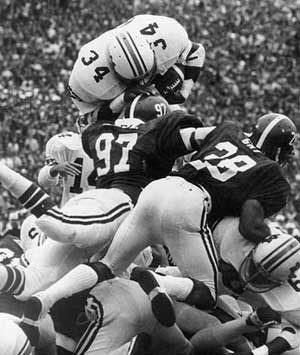The Inflation Equation 2008

(www.cfb360.com) - Two years ago many magazine prognosticators, reporters and coaches had picked
Notre Dame and Ohio State to battle for the still mythical national championship. It seemed likely on the surface based on the previous year, but they fell into the
pre-season inflation trap as
Notre Dame had no business being ranked number one or close to it.
But early predictors overweight two important factors:
1. talent at glamor positions (the Halo Effect) and
2. previous year's performance exceeding previous year's expectations (the
Hangover Effect)
The roots of the inflation equation usually go back two years. For example in 2005 some predicted a 1-5 start for ND, which was a bit silly given that talent was cresting in South Bend from
Willingham and Davie's 'good' recruiting years, and Notre Dame greatly exceeded expectations that year reaching the BCS. That created a massive Hangover effect for Weis and Notre Dame heading into 2006. When coupled with the Halo Effect, where the presence of stars at glamor positions makes the whole team seem better, Notre Dame was set up for a fall.
These two factors tend to gloss over major deficiencies or key talent losses as they did for many when evaluating Notre Dame heading into 2006. The problem?
Notre Dame returned Brady Quinn, but lost his best receiver in Maurice
Stovall and his other top receiver was already thinking baseball, which was bad enough, but the offensive line couldn't protect and the
Notre Dame defense, while talented, was caught in a coaching conundrum. Result:
Notre Dame finished the year barely in the top 20.

2007 it was as similar story with Michigan. Because Michigan disappointed in 2005, they started 2006 off ranked far lower than they should have been and became a 'surprise' team. Thus, despite some important losses on defense, these factors along with star talent at the glamor positions pushed Michigan up in the rankings for 2007. They fit the inflation equation: They returned glamor players in
Henne, Hart and
Manningham and exceeded previous year's expectations, but had major talent holes to fill.
That hangover effect creates the illusion of a rising program, but because talent is turning over every four years, teams that fit the inflation equation need to come with a warning level: past performance does not guarantee future results, but it's so easy to get caught up in the hype.
Phil Steele does a nice job stripping out the noise of the halo and hangover effects by focusing on experience and talent.
Of course, the reverse is also true. Predictors tend to be blinded by poor performance in a previous year and ignore rapidly maturing talent. Traditionally, Freshmen have little impact. Sophomores have some impact, but it isn't until their junior years that most athletes start maturing into difference makers. For instance, Michigan was far underrated going into 2005 because the Wolverines had accumulated an impressive talent base that was just maturing.
Florida started last year at #3 in the coaches poll despite losing a ton of talent on defense. Why? They far exceeded expectations in 2006 and returned
Tebow and
Harvin. Louisville was in a triple whammy position. They exceeded expectations and returned
Brohm, but lost their
hea
d coach and bottomed out in 2007. Meanwhile, Boston College had quietly accumulated an impressive cast of senior and 5
th year players and was in a strong position to take advantage of the talents of Matt Ryan. Give me a team with dominant senior lines over one with glamor boys any day. You can't run or pass without blocking, but even an average back can get yards behind a good offensive line. All things being equal, I'll take an experienced player who may not have had star recruiting accolades, but has physically matured over a player with star potential.
Who fits the overrated mold in 2008? Surprisingly, Georgia. The Bulldogs are a preseason #1 according to Coaches Poll,
Lindys and The Sporting News and return Matthew Stafford and
Knowshon Moreno at the glamor positions after exceeding expectations last year. But the Bulldogs will have new starters at four of the five positions on the offensive line and four of the five starters will likely be sophomores. Not a good situation as offensive linemen don't usually become effective until their junior years and often don't hit their potential until their senior years. Against the
Dawgs' schedule, that's not a recipe for a national championship run. Counterbalancing that deficit, Georgia returns a deep and talented defensive unit, but the sexy

pick isn't always the sensible pick.
Halo and Hangover effects aside, if you look at experience and talent together, four teams stick out.
No one's accumulated more talent recently than Florida and
USC and they are both returning experience as well as glamor players. Both also underperformed against high expectations last year.
Oklahoma's great classes from years ago are now maturing and the
Sooners now have the talent and depth of a number one team.
One team that many in the South will discount this year because of their recent
BCS performances is Ohio State, but they're returning almost their entire team (with one notable loss,) will have a tested senior quarterback and, most importantly, with have four of five returning starters (four of whom are seniors) blocking for glamor back Beanie Wells who has as much talent as any running back in football. Wells, now a junior, will likely reach his full potential this year.
After opening with their usual cupcakes, the Buckeyes will have a much anticipated clash against
USC. If they win they'll be a heavy favorite to win out in a suspect Big Ten, but even if they lose, they still have a great shot at making the title game this year.







